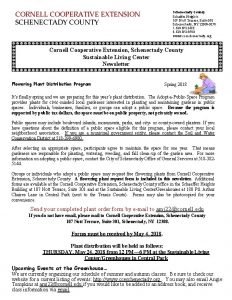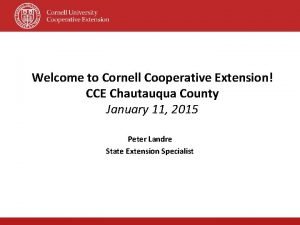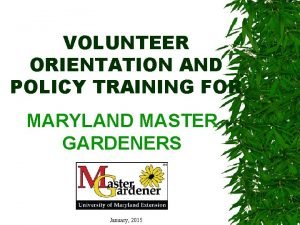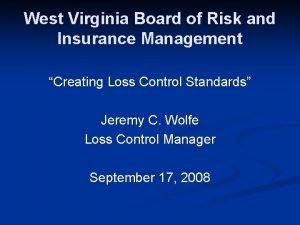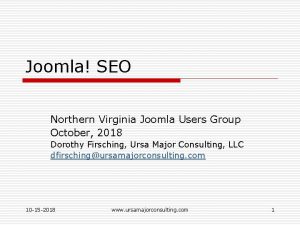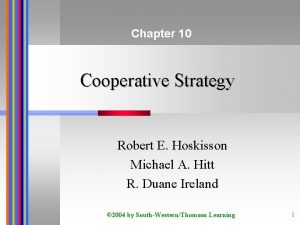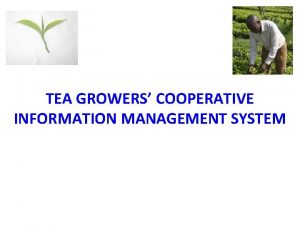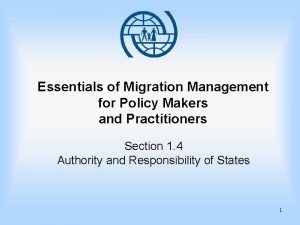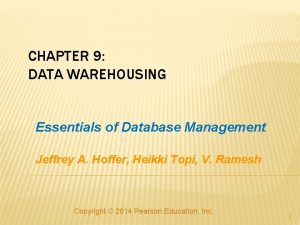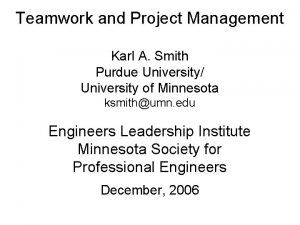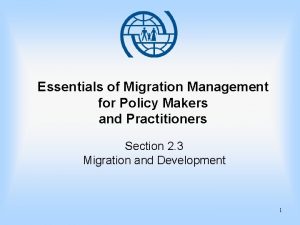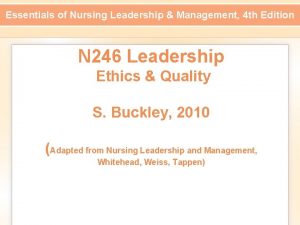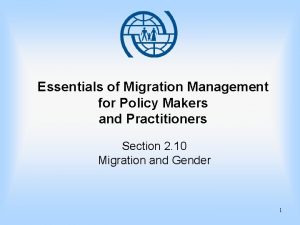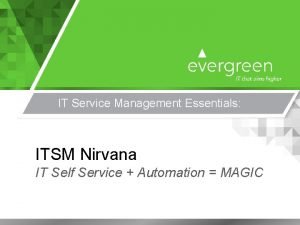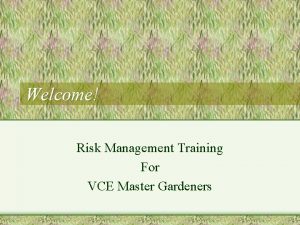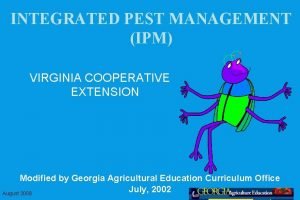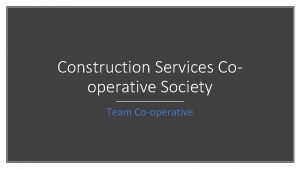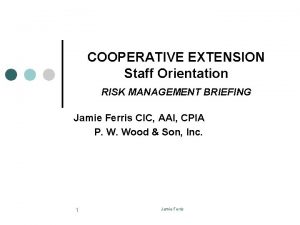Risk Management Essentials Virginia Cooperative Extension Master Gardeners


































- Slides: 34

Risk Management Essentials Virginia Cooperative Extension Master Gardeners

What is Risk Management? • Procedures that we have in place to minimize the possibility that some future event could cause harm 2

Why Risk Management? • Provides protection for our: • • 3 Program Organization Sponsors / Collaborators Volunteers

Who is Risk Management? Associate Director – Ellen Douglas North End Center Suite 3300 Turner Street NW Blacksburg, VA 24601 540 -231 -7439 Office Manager – Michelle L Tompkins 540 -231 -7439 FAX 540 -231 -5064 8: 00 -5: 00 M-F http: //www. co. vt. edu/Risk/ http: //intra. ext. vt. edu/policies/riskmgt. html 4

Overview • Requirements to be Insured • Liability (and Negligence) • Risk Management Process • Insurance and Who is Insured? • Certificates of Insurance and Contracts • Emergency Cards and Incidents • Suspicion of Child Abuse/Above Suspicion Policy • Blood Borne Pathogens

Requirements to be Insured: As volunteers for Virginia Cooperative Extension (VCE), you have liability insurance through the Virginia Division of Risk Management, if these qualifications are met: • You must be enrolled as a Virginia EMG volunteer • The activity must be an approved project Note: Criminal actions and intentional misconduct are not covered.

Liability and Negligence (Defined) • Liability is synonymous with “responsibility. ” Must be aware of your responsibility as it relates to liability when planning programs.

Avoid being Negligent: • Negligence Failure to do- or not to do- what a reasonable or prudent person would have done in the same or similar situation • 8 In order to prove the negligence of another person, the following four elements must be present in the situation.

Element #1 “Existence of a legal duty to protect the injured party from reasonable risks of harm that can be reasonably foreseen. ” You need to recognize when you have duty of care for other individuals.

Be Aware of Duty of Care: The legal obligation which is imposed on an individual requiring adherence to a standard of reasonable care while performing any acts that could foreseeably harm others. It is the first element that must be established to proceed with an action in negligence. 10

Element #2 “A failure to perform that duty of care. Ignorance and inexperience are no excuse. Inability to perform will eventually lead to problems. ” You should be aware of the risks associated with your activities, anticipate problems, and plan and follow ways to make your activities safe for everyone involved.

Element #3 “An injury suffered by the claimant (person filing the claim). Injury may be physical, mental or property. ” An accident or injury must occur in order for you to be liable.

Element #4 “A reasonably close causal relationship between the breach of duty and the claimant’s injury. ” It must be proved that what you did or failed to do is the reason for the accident or injury.

Categories of Exposure: 1. Liability 2. Personnel 3. Property 4. Net Income

Risk Management Process Planning for the Best and the Worst • Program planning (risk management plan), documentation, and the training that you provide to your representatives (staff and volunteers) • Be aware of…. • Document…. • Waivers….

Risk Management Process (Again) • Evaluate Exposure to Risk • Identify Techniques for Handling Risk • Implement Techniques • Evaluate and Adjust

Insurance Types and Claims Forms • Workman’s compensation • Not for volunteers • Submit first report of injury immediately • Automobile liability • $2, 000 per occurrence • State-owned vehicles (not personal vehicles) • Authorized Drivers • School Buses and Rental Cars • General liability coverage • $2, 000 per occurrence (not including law violations) • Property • Full coverage (less a $1, 000 deductible)

Who is insured? • Virginia Tech provides liability coverage to University employees and volunteers • Remember- the coverage is for liability and not for injury to the employee or volunteer • Each volunteer should verify that they have health insurance. If the volunteer is injured, then he/she should file the injury with personal carrier

Certificates of Insurance • You may need to request a certificate-of-insurance from an individual or group that provides a program

Certificates of Insurance • You may need to provide a certificate-of-insurance (from VT) to an individual or group that is involved in a program (make request to the VT Office of Risk Management) • http: //www. co. vt. edu/Risk/ • John Urquhart Request Form 540. 231. 7439

Contracts • Must be authorized by University Representative • Contact VCE State Office – Nicole Martin • Field and District staff are not authorized to sign • Volunteers are not authorized to sign

Emergency Cards • The VCE Emergency Card outlines the procedures to be followed in the event of a “serious accident or emergency” • Should be carried at all times by VCE staff and volunteers • Can be ordered (publication # 490 -101) • http: //www. pubs. ext. vt. edu/490 -101/490 -101. html

23

24

If there is an Incident: • Use the Accident/Incident Form (facts only) http: //www. co. vt. edu/Risk/liability. doc • Submit the Accident / Incident Report for: • Personal injuries or accidents to participants or volunteer • Serious injuries (fractures, injuries involving sutures, injuries requiring a hospital stay, etc. )

Serious Incidents: • Serious multiple injuries, or fatalities, • Incidents that involve law enforcement, • Or incidents that may result in litigation • Also, be sure to follow the Emergency Procedures card guidelines

Working with Youth: • Volunteers need training on Working with Youth from the 4 -H Agent or designated Agent prior to participating in youth based programs. • 4 -H does not work with youth below the age of 5. Volunteers working with youth under age 5 should ask their supervisor to verify that they have liability coverage for this work. 27

Working with Youth: • Youth completing 6 or more hours of VCE educational programming (including programs conducted by MGs) are always enrolled in 4 -H. • For shorter term programs (such as Seeds of Learning or Enviroscape demos), 4 -H enrollment is not required. 28

Above Suspicion Policy • Purpose • To provide a safe and caring environment for youth and adults in all program situations • To protect salaried and volunteer staff from accusations of abuse • Avoid one-on-one situations by staying in groups of 3 at all times

Suspicion of Child Abuse • Anyone involved in the “education or care of children” has the responsibility to report any allegation, accusation, or suspicion of child abuse • Suspicion defined as “reasonable cause to believe that an individual has been abused or neglected” • Report to your local Social Services Department • Toll-free child abuse/neglect hotline (1 -800 -552 -7096) • Confidential, and if there is doubt, call!

Blood-borne Pathogens • Definition: infectious agents that are carried in blood or other bodily fluids • Exposure: contact with potentially infectious bodily fluid through inhalation, needle sticks, or other contact with open wounds, broken skin, eyes, or mucus membranes. • Contact of blood or bodily fluids onto intact skin does not signify an exposure!

Blood-borne Pathogens • Keep a first aid kit available • Wear disposable latex gloves in all first aid situations. Wash hands/exposed skin, or use waterless, germicidal hand cleaner, as soon as possible after removing gloves. • After any accidental contact with potentially infectious materials, wash as listed above. • In the event of eye or mucus membrane contact with potentially infectious materials, flush the area with water immediately. For this situation or other actual exposures (as defined), contact the Environmental Health and Safety Office at Virginia Tech (540 -231 -8751) for further instructions.

In Summary… • Anticipate hazards and plan accordingly • Carry the Emergency Procedures information • Be familiar with the liability insurance that is provided to you as a VCE volunteer • Questions? Ask your VCE Agent, the State MG Coordinator’s Office, or the Office of Risk Management.

Questions / Comments?
 Master media
Master media Pima master gardeners
Pima master gardeners Durham master gardeners
Durham master gardeners Durham master gardeners
Durham master gardeners Napa tree care
Napa tree care Cornell cooperative extension schenectady
Cornell cooperative extension schenectady Cornell cooperative extension chautauqua county
Cornell cooperative extension chautauqua county Oklahoma cooperative extension service
Oklahoma cooperative extension service Virginia master gardener volunteer management system
Virginia master gardener volunteer management system Market risk assessment
Market risk assessment Brand leveraging strategies
Brand leveraging strategies Wv board of risk and insurance management
Wv board of risk and insurance management Seo northern virginia virginia
Seo northern virginia virginia Fiduciary investment risk management association
Fiduciary investment risk management association Risk map
Risk map Cooperative strategy in strategic management
Cooperative strategy in strategic management Treacability
Treacability Essentials of migration management
Essentials of migration management Data warehouse essentials
Data warehouse essentials One purdue success factors
One purdue success factors Essentials of migration management
Essentials of migration management Essentials of nursing leadership & management
Essentials of nursing leadership & management Essentials of migration management
Essentials of migration management Management information systems 13th edition
Management information systems 13th edition Service management essentials
Service management essentials Risk projection in software engineering
Risk projection in software engineering Risk avoidance
Risk avoidance How to calculate relative risk
How to calculate relative risk Residual risk and secondary risk pmp
Residual risk and secondary risk pmp Tracing vs vouching
Tracing vs vouching Absolute risk vs relative risk
Absolute risk vs relative risk Activity sheet 2 stock market calculations answer key
Activity sheet 2 stock market calculations answer key Medium risk examples
Medium risk examples Pembelanjaan risiko adalah
Pembelanjaan risiko adalah The biggest risk is not taking any risks
The biggest risk is not taking any risks





